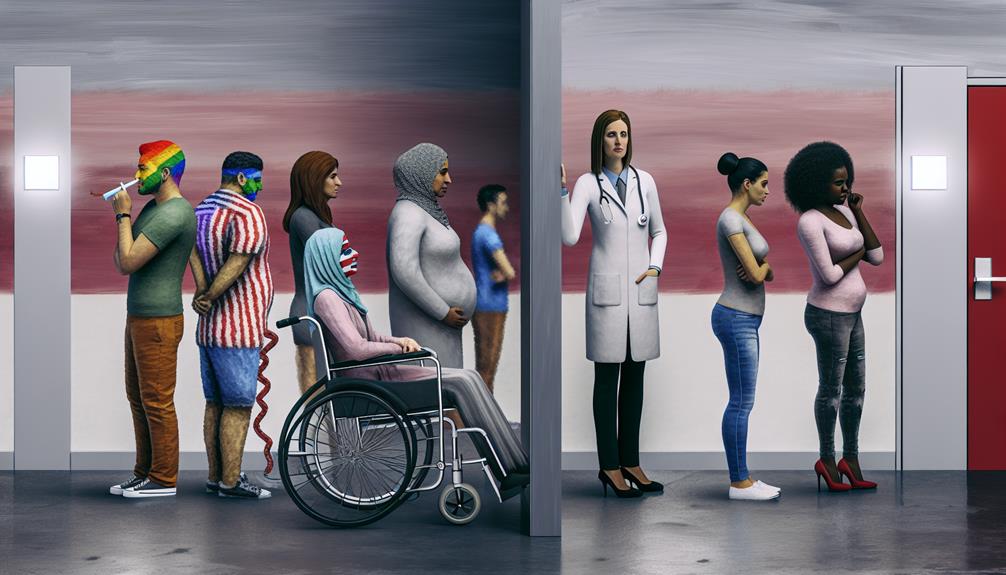Exploring the intersection of race, sexual orientation, and identity in healthcare reveals significant disparities in access, treatment, and outcomes for marginalized communities. Historical discrimination has left a legacy of systemic barriers, fostering mistrust and hindering effective healthcare delivery. Culturally competent care is essential for affirming the identities of patients and improving their overall experiences. Advocacy and policy changes are needed to dismantle stereotypes and address the unique challenges faced by diverse populations. By understanding these interconnections, we can take meaningful steps towards creating an inclusive healthcare environment that respects and uplifts all individuals. Insights on this topic are important for fostering change.
Key Takeaways
- Intersectionality highlights how race, sexual orientation, and identity intersect to influence healthcare access and experiences for marginalized communities.
- Historical discrimination and systemic barriers continue to create health inequities affecting marginalized groups' access to quality care.
- Implicit bias in medical practices contributes to disparities, necessitating stigma reduction and cultural sensitivity training among healthcare providers.
- Language barriers and financial constraints hinder effective communication and access to services, exacerbating health disparities.
- Culturally competent care and community engagement are vital for fostering trust and improving health outcomes in diverse populations.
Understanding Intersectionality

At the confluence of numerous social identities, intersectionality serves as a critical framework for understanding how various forms of discrimination and privilege intersect in the healthcare system. This concept illuminates the complexity of identity formation, emphasizing how social determinants such as race, gender, and sexual orientation shape individual experiences and access to care. Additionally, understanding the importance of holistic wellness practices, such as the calming effects of herbal teas like Sleepytime, can provide insights into how marginalized communities seek alternative methods to promote well-being and manage stress soothing effects of herbal teas.
Community engagement becomes essential in fostering cultural resilience, allowing marginalized groups to advocate for their rights and needs. Intersectional advocacy highlights the necessity of addressing systemic bias that permeates healthcare practices, ensuring that all voices are heard in identity politics. By examining privilege dynamics, we recognize how certain groups may navigate the healthcare landscape with greater ease, while others face barriers that hinder their healthcare literacy.
Belonging narratives emerge from these discussions, illustrating how individuals seek connection and understanding within diverse communities. This holistic perspective encourages a more empathetic approach to healthcare delivery, paving the way for inclusive policies and practices. Ultimately, understanding intersectionality not only enriches our comprehension of healthcare disparities but also fosters a sense of belonging for all individuals within the healthcare system.
Historical Context in Healthcare
The historical context of healthcare reveals a complex tapestry of discrimination that continues to shape access to care for marginalized communities. For instance, the health challenges faced by public figures, such as Bruce Willis's health journey, highlight how personal experiences can reflect broader systemic issues. Examining past injustices, such as biased medical practices and systemic barriers, is essential for understanding the ongoing inequities in health outcomes. By acknowledging these experiences, we can better advocate for a more equitable healthcare system that fully addresses the needs of all individuals, regardless of their racial or cultural identity.
Discrimination in Medical Practices
Historically, medical practices have often been marred by discrimination, reflecting broader societal biases that permeate various aspects of life. Implicit bias among healthcare providers can lead to significant healthcare disparities, particularly affecting marginalized communities. For instance, individuals from racial and ethnic minorities frequently encounter racial profiling, which undermines patient trust and discourages them from seeking necessary care.
Addressing these issues requires robust provider education focused on cultural sensitivity and the unique needs of diverse populations, including LGBTQ+ health. By fostering an understanding of the intersectionality of race and sexual orientation, healthcare professionals can better serve all patients. Stigma reduction is essential in promoting an inclusive environment where individuals feel safe and valued.
Furthermore, patient advocacy plays a vital role in challenging discriminatory practices and ensuring that inclusive policies are enacted within healthcare systems. By prioritizing the voices of those affected, healthcare providers can create a more equitable landscape. Ultimately, embracing these approaches not only enhances patient experiences but also contributes to a more just and compassionate healthcare system, where every individual is treated with dignity and respect.
Access to Care Inequities
Access to care inequities have persistently shaped the healthcare landscape, revealing deep-rooted systemic barriers that disproportionately affect marginalized populations. These barriers manifest in various forms, including insurance disparities and socioeconomic factors, which often limit access to preventive care. Cultural barriers, education gaps, and provider biases further complicate the healthcare experience for many individuals.
The following table illustrates some key factors contributing to access inequities:
| Factor | Impact on Access to Care |
|---|---|
| Telehealth Access | Enhances reach but may lack equity for those with limited technology |
| Insurance Disparities | Creates financial barriers for marginalized communities |
| Socioeconomic Factors | Affects ability to prioritize health needs |
| Language Obstacles | Hinders effective communication and understanding |
| Urban-Rural Divide | Limits availability of resources in rural areas |
Community outreach initiatives are essential to bridge these gaps, as they promote awareness and address cultural sensitivities. By recognizing and actively confronting these inequities, we can foster a more inclusive healthcare system where every individual feels valued and empowered to seek care.
Marginalized Communities' Experiences
Understanding the historical context of marginalized communities' experiences in healthcare reveals a tapestry woven with threads of discrimination, neglect, and resilience. Historically, individuals from marginalized backgrounds have faced systemic barriers that hinder their access to quality care, often leading to compounded mental health challenges. The absence of culturally competent care has not only affected healthcare navigation but has also undermined the affirmation of their cultural identity.
However, community resilience has emerged as a powerful tool for combating these challenges. By fostering social support networks, marginalized groups can promote patient empowerment and enhance trust building with healthcare providers. This supportive environment encourages individuals to seek care without the burden of stigma, facilitating better health outcomes.
Moreover, intersectional advocacy plays an essential role in addressing the unique needs of diverse populations. By prioritizing stigma reduction and creating inclusive healthcare policies, we can guarantee that all individuals feel safe and respected within the healthcare system. Ultimately, prioritizing these elements fosters an environment where marginalized communities can thrive, empowering them to reclaim their health journey and reinforcing their rightful place within the healthcare narrative.
Health Disparities and Outcomes

Health disparities are profoundly influenced by systemic inequities that shape access to quality care across different populations. Remote customer service jobs can play a role in addressing these disparities by providing flexible work opportunities that help promote economic stability. These inequities not only affect individual health outcomes but also perpetuate cycles of disadvantage within marginalized communities. Understanding this intersection is essential for developing equitable healthcare policies that promote better health for all.
Impact of Systemic Inequities
Systemic inequities in healthcare manifest as significant barriers that disproportionately affect marginalized communities, leading to stark health disparities and adverse outcomes. These systemic barriers, rooted in historical injustices and ongoing discrimination, hinder the ability of individuals to access necessary care and achieve ideal health. Equity frameworks are essential to understanding and addressing these challenges, as they provide a structured approach to dismantling the obstacles faced by diverse populations.
Key factors contributing to the impact of systemic inequities include:
- Socioeconomic Status: Lower income levels can limit access to healthcare resources and opportunities for wellness.
- Cultural Competence: A lack of understanding and respect for diverse cultural backgrounds can result in inadequate care and mistrust in the healthcare system.
- Policy Gaps: Legislative shortcomings often fail to protect the rights and needs of marginalized groups, perpetuating inequities.
- Geographic Disparities: Rural and underserved urban areas frequently lack essential healthcare services, worsening outcomes for residents.
Recognizing these systemic barriers is vital for fostering an inclusive healthcare environment that promotes equity and ultimately leads to improved health outcomes for all communities.
Access to Quality Care
Accessing quality care remains a significant challenge for many individuals, particularly those from marginalized communities who often face compounded barriers. These barriers can include socioeconomic status, geographic location, and systemic discrimination, creating disparities in health outcomes. For many, the traditional healthcare system may feel unwelcoming or inaccessible, leading to a reluctance to seek necessary care.
Telehealth accessibility has emerged as an essential solution, offering an alternative for individuals who may struggle to navigate conventional healthcare settings. Virtual platforms can bridge gaps, especially in underserved areas, enhancing community health by providing timely and convenient access to medical advice and support. However, disparities in technology access and digital literacy must be addressed to guarantee equitable participation in telehealth services.
Furthermore, fostering inclusive healthcare environments that acknowledge and validate diverse identities is important for improving health outcomes. By prioritizing culturally competent care, healthcare providers can build trust and encourage individuals to engage with the system confidently. Ultimately, addressing these multifaceted challenges is critical for creating a more equitable healthcare landscape, where all individuals feel valued and empowered to access quality care.
The Role of Stereotypes
Stereotypes serve as a lens through which individuals often view and interpret the healthcare experiences of racially and ethnically diverse populations. These preconceived notions can perpetuate racial bias and reinforce sexual stereotypes, negatively impacting the quality of care received by marginalized identities. Recent discussions in the automotive industry, particularly regarding latest Tesla updates, illustrate how perceptions can shift based on cultural narratives. Identity assumptions rooted in cultural misconceptions often lead to healthcare myths that diminish the validity of patient experiences.
To address these issues, it is essential to recognize the following:
- Intersectional stereotypes can compound stigma, making it more challenging for individuals to seek help.
- Cultural misconceptions can result in misdiagnosis or inadequate treatment, as healthcare providers may rely on erroneous beliefs about specific groups.
- Healthcare myths contribute to a lack of trust in medical institutions, particularly among communities that have historically faced discrimination.
- Stigma reduction efforts must involve education and advocacy to dismantle harmful stereotypes that obstruct access to quality care.
Culturally Competent Care

Culturally competent care is essential for ensuring that all patients feel understood, respected, and valued within the healthcare system. This approach emphasizes cultural humility, where healthcare providers recognize their own biases and engage in ongoing learning about diverse identities. By implementing effective communication strategies, healthcare professionals can foster patient empowerment and encourage open dialogues about health concerns.
Inclusive practices, such as training programs focused on cultural awareness, are vital for addressing the unique needs of various communities. Community engagement initiatives can further enhance trust and collaboration between healthcare providers and patients, promoting identity affirmation and fostering a sense of belonging.
The following table summarizes key elements of culturally competent care:
| Element | Description | Impact on Patients |
|---|---|---|
| Cultural Humility | Acknowledging personal biases and learning | Builds trust and rapport |
| Communication Strategies | Tailoring interactions to individual needs | Enhances understanding and clarity |
| Inclusive Practices | Implementing policies that reflect diversity | Increases patient satisfaction |
| Training Programs | Educating staff on cultural awareness | Improves care quality |
| Community Engagement | Collaborating with local organizations | Strengthens health literacy |
Incorporating these elements can lead to improved health outcomes and a more equitable healthcare environment.
Patient Experiences and Narratives
Understanding patient experiences and narratives is essential for developing a more nuanced perspective on healthcare delivery. Patient storytelling serves as a powerful tool for identity validation, allowing individuals to articulate their lived experiences and the cultural narratives that shape their healthcare journeys. In a similar way that text messaging lacks immediate nonverbal cues, patient narratives can sometimes be misinterpreted without the appropriate context. These personal testimonies not only foster a sense of belonging but also highlight the emotional resilience required to navigate complex healthcare systems.
Consider the following elements that underscore the importance of patient experiences:
- Cultural Narratives: Acknowledge how diverse backgrounds influence health perceptions and interactions with providers.
- Identity Validation: Recognize the significance of affirming patients' identities within clinical settings.
- Emotional Resilience: Understand how patients draw upon personal strength to confront health challenges.
- Social Support: Emphasize the role of community and relationships in enhancing patient well-being.
Barriers to Access

Access to healthcare is often obstructed by a complex array of barriers that disproportionately affect marginalized communities. Language barriers can create significant obstacles, preventing effective communication between patients and providers, which is crucial for accurate diagnosis and treatment. Transportation issues further compound this problem, as many individuals face challenges in reaching healthcare facilities. Financial constraints, including insurance disparities, often force people to forgo necessary care, while cultural stigma surrounding certain health issues can discourage individuals from seeking help.
Moreover, trust deficits between marginalized communities and healthcare providers, exacerbated by historical discrimination, contribute to reluctance in accessing services. Technology access also plays a critical role; those without reliable internet or devices may struggle to utilize telehealth options that have become increasingly essential. Social isolation can lead to additional hurdles, as individuals may lack a support system to accompany them during visits or advocate for their needs. Geographic challenges, particularly in rural areas, limit access to specialized care, perpetuating inequities. Together, these barriers create a multifaceted landscape that requires targeted efforts to guarantee that all individuals can engage fully with the healthcare system, fostering a sense of belonging and security.
Advocacy and Policy Changes
While systemic barriers in healthcare create significant challenges for marginalized communities, effective advocacy and policy changes can serve as powerful tools to dismantle these obstacles and promote equity. The intersection of race, sexual orientation, and identity necessitates a multifaceted approach to address disparities and foster inclusive practices.
To achieve meaningful change, several key strategies must be employed:
- Policy Advocacy: Engaging stakeholders to support legislative reforms that prioritize healthcare equity.
- Community Engagement: Involving affected communities in decision-making processes to guarantee their voices are heard and valued.
- Funding Initiatives: Allocating resources to programs that directly address the healthcare needs of marginalized groups.
- Grassroots Movements: Mobilizing local efforts to raise awareness and push for policy analysis that reveals inequities in the healthcare system.
Future Directions in Healthcare

As advocacy and policy changes lay the groundwork for more equitable healthcare systems, the future directions in healthcare must prioritize innovation and inclusivity to address the evolving needs of diverse populations. Telehealth innovations represent a critical component of this future, enabling access to care for marginalized communities that have historically faced barriers. Inclusive policies must be developed to guarantee that all individuals, regardless of race or sexual orientation, benefit from advancements in technology equity.
Community partnerships will play an essential role in bridging gaps in healthcare delivery, fostering environments that are conducive to preventive care and mental health support. Education initiatives that emphasize the importance of diversity training among healthcare professionals will enhance cultural competency, fostering an atmosphere of belonging for all patients.
Moreover, increased research funding is crucial to explore the unique challenges faced by diverse groups in healthcare settings. Strengthening patient advocacy efforts will empower individuals to voice their needs and experiences, driving systemic change. By aligning these strategies, the healthcare sector can cultivate a more inclusive environment that not only recognizes but celebrates the rich tapestry of identities and experiences within our communities.
Frequently Asked Questions
How Does Intersectionality Affect Mental Health Treatment Options?
Intersectionality greatly influences mental health treatment options by necessitating cultural competence among healthcare providers. Understanding the diverse experiences of individuals allows for tailored interventions that respect their identities. This approach not only enhances therapeutic relationships but also fosters stigma reduction, enabling patients to engage more openly in their care. By addressing the multifaceted nature of identity, mental health professionals can create inclusive environments that promote belonging and improve overall treatment outcomes for marginalized communities.
What Role Do Healthcare Providers Play in Supporting Lgbtq+ Patients of Color?
Healthcare providers play a vital role in supporting LGBTQ+ patients of color by fostering an environment of inclusivity and understanding. By enhancing cultural competency, providers can better address the unique challenges faced by these individuals. Recognizing and mitigating implicit bias is essential in ensuring equitable care. Providers must actively engage in ongoing education and training, creating a safe space that promotes trust, encourages open dialogue, and ultimately improves health outcomes for marginalized communities.
Are There Specific Health Screenings Recommended for Marginalized Communities?
Marginalized communities often face unique health challenges that necessitate culturally competent screenings and targeted health interventions. Specific recommendations may include mental health assessments, sexually transmitted infection screenings, and chronic disease monitoring tailored to their demographic needs. By prioritizing such screenings, healthcare providers can address disparities, promote equitable access to care, and foster an inclusive environment. This approach not only enhances health outcomes but also empowers individuals to engage actively in their healthcare journeys.
How Can Patients Advocate for Their Intersectional Identities in Healthcare Settings?
Patients can advocate for their intersectional identities in healthcare settings through active patient empowerment and identity recognition. This involves openly communicating their unique experiences and needs to healthcare providers, fostering an inclusive dialogue. Additionally, patients can seek support from advocacy groups that emphasize the importance of diverse identities. By educating themselves on their rights and available resources, patients can enhance their healthcare experiences, ensuring that their multifaceted identities are respected and addressed.
What Resources Are Available for Intersectional Healthcare Education?
Numerous resources exist to enhance intersectional healthcare education, emphasizing culturally competent care and inclusive policies. Organizations such as the National LGBTQIA+ Health Education Center and the Center for Disease Control and Prevention provide training modules and guidelines. Additionally, community workshops and online courses foster understanding of diverse identities, ensuring healthcare professionals are equipped to address the unique needs of all patients. Such initiatives promote empathy and belonging within healthcare environments, ultimately improving patient outcomes.


